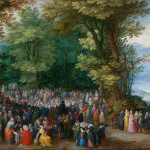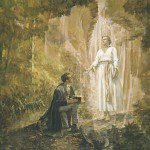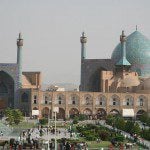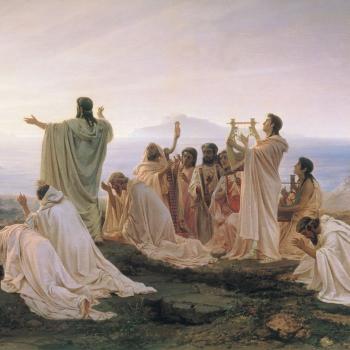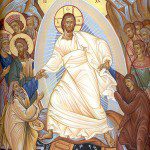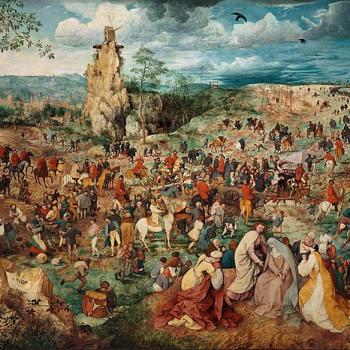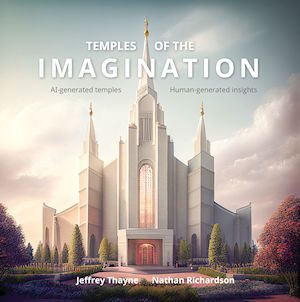
In cooperation with Verdant Press and Eborn Books, the Interpreter Foundation has just published an unusual new book by Jeffrey Thayne and Nathan Richardson under the title of Temples of the Imagination: AI-Generated Temples, Human-Generated Insights. It holds special interest for me because, at one very youthful point, I briefly dreamed of being an architect. I had fallen in love with the work of Frank Lloyd Wright and had been influenced by Ayn Rand’s novel The Fountainhead (not a coincidental pairing, as those who know a little bit about both will realize), and I particularly imagined myself designing spectacular temples. However, I soon abandoned the dream when I realized that I’ve been blessed with absolutely no visual talent — something that, I’ve noticed since then, hasn’t stopped all aspiring architects from enjoying successful careers.
***
This past Friday, Interpreter: A Journal of Latter-day Saint Faith and Scholarship published a review-essay on Daniel Becerra, Amy Easton-Flake, Nicholas J. Frederick, and Joseph M. Spencer, Book of Mormon Studies: An Introduction and Guide (Provo, UT: Religious Studies Center, Brigham Young University, 2022). Entitled “Moving Beyond the Historicity Question, or a Manifesto for Future Book of Mormon Research,” the review was written by Newell D. Wright. In case you missed it, I want to highlight a passage from it for you here:
This privileging of the Journal of Book of Mormon Studies does not seem to be warranted by impact on the discipline of Book of Mormon studies, as measured by a citation analysis. Articles in Interpreter are likely to be cited twice as often as articles appearing in the Journal of Book of Mormon Studies. Using Harzing’s Publish or Perish software, I pulled all articles that have citation data from Google Scholar from 2012 to 2018 from the Journal of Book of Mormon Studies and compared them with articles about the Book of Mormon published in the Interpreter during the same period. Newer articles are cited less frequently than older articles, so I did not include anything newer than 2018. Also, older articles are cited more frequently, as they have been around longer, so I did not look at articles published before 2012.
The Journal of Book of Mormon Studies published 35 articles of all types that were cited at least once during that time period, for a total of 91 citations, or 2.68 citations per article. Interpreter published 69 articles focusing on the Book of Mormon that were cited at least once during that time period, for a total of 391 citations, or an average of 5.75 citations per article — more than double the citation rate of the Journal of Book of Mormon Studies. I believe that the influence of the Journal of Book of Mormon Studies will continue to wane, because it is now locked behind a paywall and is not freely available to the three target audiences described at the beginning of Book of Mormon Studies. This same analysis suggests a bright, impactful future for Interpreter. This blindness towards the Interpreter is one example of the authors’ unconscious bias.
I cite this not to criticize the Journal of Book of Mormon Studies but, rather, to point to the apparent impact and reach of Interpreter. Faithful students of the Book of Mormon who want to publish their work and who want it to reach a wide audience will (increasingly) want to consider submitting it to Interpreter for consideration. I don’t guarantee publication, of course — we have a vigorous system of peer review in place and, anyway, not every submitted manuscript fits our mission even if it’s really well done — but please do think of this as an invitation. We don’t care what academic credentials an author may or may not possess; we care only that submitted manuscripts be solid and of interest.
I also hope that potential donors, learning of the growing reach of the Interpreter Foundation, will want to join with us in this cause. (See Donating to The Interpreter Foundation.)
***
I encourage you to watch and, if possible, to share the new 2023 Easter video from the Church of Jesus Christ of Latter-day Saints: “Because of Jesus, You Can Rise Above Anything – Easter 2023 | “Rise”” There is also a new Easter-themed concert video from the Church in Europe: “Celebrate Easter With Streamed Concert, New Videos.” Also not to be overlooked: “First Presidency’s 2023 Easter Message: Savior’s sacrifice gives ‘hope for joy and peace,’ Church leaders write, inviting all to ponder the ‘glorious promise’ of the Savior’s Resurrection”
***
It has been good to be out of Israel for the past three days. We managed to avoid Tel Aviv proper during this most recent visit — that’s where the largest recent demonstrations have been taking place — but we did see demonstrators at the Supreme Court building in Jerusalem.
***
On the flight from Boston to Salt Lake City on Saturday morning, I overheard a youngish male voice behind me ask “Who goes to Salt Lake City? Why would anybody go there? What’s there? It’s in the middle of nowhere.” An older female voice responded “It’s in the desert. Like Nevada.”
A few years back, The Atlantic published a good article about the Church of Jesus Christ of Latter-day Saints: “The Most American Religion: Perpetual outsiders, Mormons spent 200 years assimilating to a certain national ideal—only to find their country in an identity crisis. What will the third century of the faith look like?”
Among others, I was struck by this passage regarding the hit Broadway musical The Book of Mormon, a passage that strikes me as precisely right: “But then I met a theater critic in New York who had recently seen the musical. He marveled at how the show got away with being so ruthless toward a minority religion without any meaningful backlash. I tried to cast this as a testament to Mormon niceness. But the critic was unconvinced. “No,” he replied. “It’s because your people have absolutely no cultural cachet.””
How to develop “cultural cachet”? This is where a horde of faithful Latter-day Saint composers, playwrights, actors, novelists, artists, and thinkers would come in handy. Plus, we have a really interesting history to tell, with lots of drama. And our demographic center in the Great Basin West features a lot of spectacular terrain that should draw even more interest from tourists than it already does. But I doubt that achieving “cultural cachet” is a realizable goal for us. And we certainly shouldn’t seek it directly, let alone with pathetic desperation. It would be very nice if we were to be more engaged with the wider culture, neither completely disregarded because of our seeming oddness nor having sold out by “aping the Gentiles.” And perhaps that day will come. However, even then our image as nice and polite, but prim, naïve, weird, and intellectually dull — the likable simpletons of The Book of Mormon on Broadway and in London — will almost certainly continue with us, whether or not it’s really deserved.
Our continuing (though much lessened) isolation in Utah and surrounding areas means that relatively few Americans or others get to know us. And, since we don’t dress distinctively (i.e., wearing hijabs or yarmulkes), people elsewhere may well not realize that their dentist, professor, carpenter, pharmacist, delivery man, nurse, attorney, plumber, kindergarten teacher, or accountant is a Latter-day Saint. They’ll only know us as the Other, Out There. Strange, foreign, and exotic while, at the same time, boring, stodgy, uninteresting, and to be avoided. (I regard Gary C. Lawrence’s How Americans View Mormonism as a really fine treatise on the topic indicated in its title, with some very practical and easy recommendations for Latter-day Saints.)


